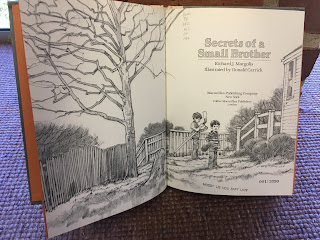Secrets of a Small Brother
 Secrets of a Small Brother
Secrets of a Small Brother
Author: Richard J. Margolis
Illustrator: Donald Carrick
Genre: Poetry
Major Awards: Christopher Award
Grade Level: 2-5
Summary: This book contains a collection of poetry that follows the relationship between a younger and older brother, written from the little brother's point of view. It contains poems about the ups and downs that many siblings go through, such as competing to be the best, trying to avoid punishment from parents, and endless teasing. It is evident throughout the poems that the little brother admires his sibling, however, and that he has learned a lot from him (both good and bad things). My personal favorites in this story include the poems in which the brothers grow closer, including one in which the younger brother covers up his older brother while he sleeps because he is sick, the older brother teaching the younger how to ride a bike, and the final poem of the series, in which the older brother saves the younger one from drowning. The book, although written from personal accounts from the author himself, perfectly captures the relationship that many siblings share, making it easy to fall in love with it.
Evaluation: I would definitely use this book in my class for many reasons. The first is that the poetry is not symbolic, making it easy to understand for children who are first being introduced to the genre. It also has illustrations with each poem, adding context for young children as well. I also think that because it is all about sibling relationships, students would be able to relate to the context and enjoy it more than they would other types of poetry.
I think that this book is most appropriate for second through fifth graders. In second grade, these would be good to read aloud as you introduce poetry to your students. It would also provide an opportunity to show them that poetry can be realistic and enjoyable. Older students could read it on their own and learn more about the structure of poetry as well.
Some lesson ideas I had while reading this book include reading the poems to students and having them write their own realistic poem based on an event in their lives. I want them to learn to express themselves in many ways, including different writing forms and styles. I think it would also be an excellent book to teach about inferencing. While the poems are mostly clear, there is still more to inference from the illustrations as well as analyze the meaning of each poem.
Kayla -- As I was reading this post, I thought about Raina Telgemeier's graphic novel, SISTERS. I wonder if that might be a good pairing with this book.
ReplyDelete